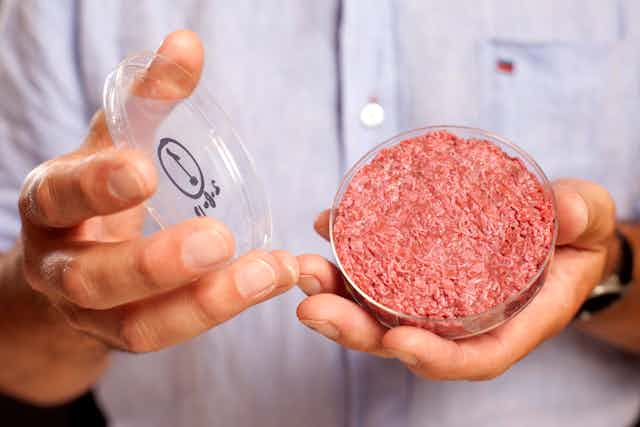When “the world’s first laboratory-grown burger” was unveiled, cooked and eaten last week, the story received saturation news coverage. But was it really the first? Or was this story served up to a ravenous media with a generous dollop of artistic nous?
Articles in Science, The Scientific American, The Washington Post and The Guardian, among many others, reported the story with considerably more relish than its tasters, who can be seen in the video below.
The ostensible significance of the burger’s unveiling and consumption last Monday lay in its potential to solve a looming crisis in meat production.
But was the laboratory-cultured meat patty really the huge scientific leap it was made out to be?
Created by Maastrict University stem cell researcher Mark Post and widely dubbed the “Frankenburger”, its meat was cultivated from bovine stem cells over a five-year period and at a cost of £250,000.
World Health Organisation figures indicate that global consumption of meat is estimated to increase by 60% to 70% over the next 40 years and, according to Post:
It’s unsustainable. We need an alternative. This hamburger illustrates that.
A big leap to mass production
Whether stem cell technology can really be scaled to allow for an affordable mass-production of cultured meat, especially within the next ten years as Post claims, is highly debatable.
Synthetic biologist Christina Agapakis commented in a Scientific American blog:
It is one small bite at a press conference, sold as one giant leap towards reducing the damaging effects of meat. These are big claims worthy of close scrutiny.
A similar note of caution could be heard in The Atlantic:
[…] we have to be careful when we talk about amazing food technologies as being a way to help “hunger” or a “hungry population” […] most actual hunger that people experience, sustainability experts believe, is not because of a lack of food in the world — lab-grown or otherwise — but rather the result of a complicated mix of poverty, natural disasters, theft, or poor land use.

The first? Not quite
Among all the media hoopla and debate, it was largely left to Post to acknowledge that his burger was not, in fact, the world’s first laboratory-grown meat.
That distinction belongs to Oron Catts and Ionat Zurr from the University of Western Australia, the award-winning experimental artists-in-residence behind the Tissue Culture and Art project.
It is now a full decade since Catts and Zurr prepared their “semi-living steak” grown from frog skeletal muscle and served up as a Nouvelle Cuisine dinner, as part of the installation Disembodied Cuisine at the exhibition L’Art Biotech in France.
This followed an earlier prototype produced in 2000, which was not eaten.
As recently as last year, Post was invited as a guest chef onto an in vitro meat style “cooking show” called ArtMeatFlesh organised and hosted by Catts in the Netherlands.
Maximum impact
The fact that the first laboratory-grown steak was produced and eaten in the context of experimental art is important, and not simply as a matter of historical record. It draws our attention to aspects of last week’s events that have largely gone unremarked.
While commentary has focused on the ethics of laboratory-engineered meat - such as whether it would be suitable for vegetarians, or would be kosher or halal - we might also consider the way scientists such as Post borrow strategies from artists to maximise the public impact of their work and increase their funding.

As the massive publicity his work has received in the last week demonstrates, Post was extremely successful in engineering not only a synthetic steak but also a public spectacle.
In this, in the carefully orchestrated PR campaign around the public preparation and consumption of his burger, Post has clearly learned from the artists whose work precedes his own.
As the exuberant neologisms like “Frankenburger” - and gleeful puns like Brave Moo World - demonstrate, playing up the strangeness of synthetic meat is a surefire way to attract public attention.
It is also a reminder of how important imagination and blue-sky thinking remain to scientific research and development.
The financial backer of Post’s burger — kept secret until its unveiling last week — has now been revealed as Google co-founder Sergey Brin.
Rather than a Frankenburger, with its echoes of 19th century scientific experimentation, what we have here might best be understood as the world’s first Googleburger: a hybrid of new technologies and new forms of flesh whose potential remains largely virtual, and whose significance is the product of spectacle as much as science.
Indeed, given Post’s acknowledgement that binding agents were added to the meat to make it look better and hold its shape, and the lack of reported independent scientific oversight of last Monday’s event, we might usefully turn to consider the terms in which the scientific status of such spectacles are reported and understood.

